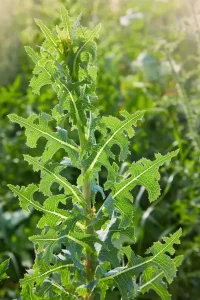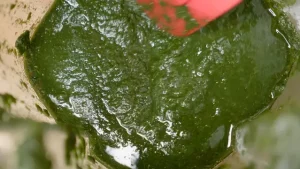As with any wild plant, it’s essential to be confident in your identification skills to avoid consuming potentially harmful lookalikes. Furthermore, always consult with a healthcare professional before using prickly lettuce or any other plant for medicinal purposes.

5. Initial Plant Preparation
After collecting your plants, they can either be dried for extended storage or utilized immediately in their fresh state. Both approaches have their merits, although I do lean towards one over the other.
Before proceeding with either method, I always remove the leaves. I’ve experimented with incorporating the stems into my extract, but found them to be more hassle than they’re worth for drying and breaking down. That said, if you own an exceptionally powerful blender, you might find the process more manageable.

Removing the leaves is a breeze. I grasp the plant and glide my hand against the direction of its growth, and the leaves detach seamlessly. However, mature plants sometimes grow secondary stems, making this process slightly more time-consuming. This is one reason why I opt for younger plants.
Diving Right in with Fresh Plants
If you’re keen to begin with fresh plants, blend the leaves with a sufficient amount of potent alcohol (I use 190 proof) to achieve a smooth consistency. Minimizing the leaf size maximizes the surface for quicker extraction.
At this point, you’ve essentially crafted a wild lettuce tincture. I let it steep, ranging from a few hours to a couple of weeks, stored in a room-temperature jar. Yet, I often favor starting with dried leaves for reasons I’ll outline below.
The Role of Alcohol in Potent Wild Lettuce Extracts

Alcohol plays a pivotal role in the initial extraction. In my trials, I compared wild lettuce extracts made solely with water against those initiated with alcohol and then followed by water. Given that Lactucin (and Lactucopicrin) have a pronounced bitter taste, it can serve as a gauge for potency. Water-only extractions always yielded a milder flavor. Conversely, beginning with alcohol invariably resulted in a strikingly bitter extract, hinting at a stronger potency.
When using dried plants, achieving a high alcohol concentration is straightforward since there’s no water content in the plant. However, fresh plants contribute water, which means you’d need a substantial amount of alcohol to maintain the desired ratio.









